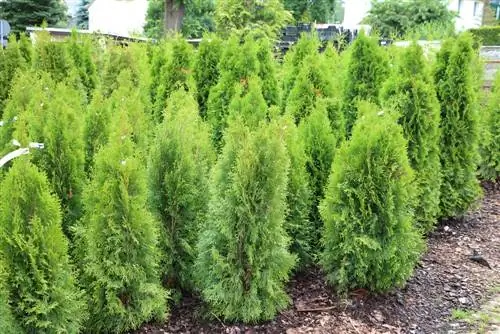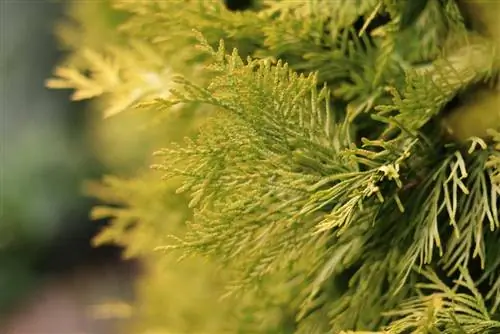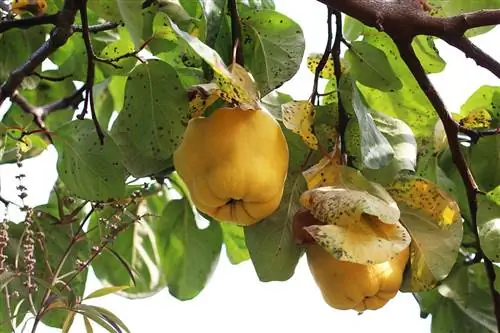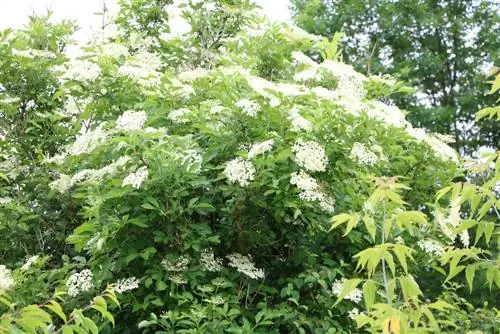- Author admin [email protected].
- Public 2023-12-17 03:39.
- Last modified 2025-01-24 12:45.
Thujas belong to the cypress family (Cupressaceae). They originally come from North America and East Asia. Some of them live up to their name and can live up to 1,500 years. Most varieties are very easy to grow and can reach considerable heights here too. There are many different varieties of arborvitae commercially available. Depending on what they will be used for, it is an advantage to know about their growth habit, shape and height before choosing a variety.
There are roughly three types of Thuja: the Western Tree of Life (Thuja occidentalis), the Eastern Tree of Life (Platycladus orientalis) and the Giant Tree of Life (Thuja plicata). Many varieties of these three Thuja species are available in garden shops.
Occidental tree of life (Thuja occidentalis)
The Thuja occidentalis is often referred to as the common Thuja. It originally comes from Canada and North America. It is well suited both as a solitary tree and for hedge planting. When planting hedges, you can expect pruning twice a year. The Western arborvitae is particularly suitable when tall, dense and sound-absorbing hedges are desired. Since this species is rather reserved in growth, the Thuja occidentalis varieties are the most popular for hedge planting.
- Growth height: 20 to 30 meters
- Age: up to 180 years
- annual height increase: 20 centimeters
- Growth habit: mostly conical, rounded tip, upward branches
Examples of varieties of Thuja occidentalis
Thuja occidentalis ‘Brabant’
The 'Brabant' is one of the most widespread hedge thujas. With an annual growth of 35 to 50 centimeters, it is one of the rather fast-growing Thujas. As a result, you should expect a little more maintenance work in the form of cutting work when planting a hedge.
Thuja occidentalis ‘Smaragd’
The 'Smaragd' is also very beautiful as a hedge thuja with its emerald green color and its slender yet compact growth. It grows a little slower than the 'Braband', with only 20 to 30 centimeters of annual growth. So it can take a while until you have a closed hedge.
Thuja occidentalis ‘Columna’
This variety grows just as slowly as 'Brabant'. However, the growth habit of the 'Columna' is columnar, wide to the tip. Some people are bothered by the increased tendency to form cones, especially in times of stress, which is why it is not found so often in stores.
Thuja occidentalis ‘Yellow Ribbon’
The Yello Ribbon is a very robust Thuja variety with bright yellow needles. It is used both as a solitary tree and for hedge planting. In terms of its growth habit and annual growth, it is similar to the 'Brabant' variety: columnar, narrow growth, up to 40 cm annual growth.
Tip:
In autumn you should water your thuja hedge and the individual arborvitae thoroughly again. Even in dry winters, remember that evergreen plants lose a lot of moisture through evaporation through their leaves.
Giant Tree of Life

The giant thuja (Thuja plicata) is one of the fast-growing thujas. It originally comes from western North America. Depending on the location and variety, the giant arborvitae grows up to 80 centimeters annually. It is also considered very robust and hardy. The giant thuja looks best as a solitary tree. Accordingly, the trunk is cut free in the nurseries and a crown is formed.
Examples of varieties of Thuja plicata
Thuja plicata ‘Martin’
The 'Martin' is characterized by a strong green, and even in winter it only loses a little of its color intensity. With an annual growth of 40 to 60 centimeters, it is way ahead and is our most popular Thuja plicata variety. It is also ideal for particularly tall hedge planting.
Thuja plicata ‘4ever Goldy’
Another well-known giant thuja variety is the '4ever Goldy'. It shines in a bright golden yellow color. The Goldy grows pyramid-shaped and looks more like a bush than a tree. In the garden it reaches a height of three meters and grows up to 1 meter 20 wide. The annual growth is 20 to 30 centimeters.
Thuja plicata ‘Excelsa’
The 'Excelsa' is a large, upright solitary tree that grows up to 15 meters high and four meters wide. It grows in a narrow, conical shape and is considered to be a strong grower, with a growth rate of around 40 centimeters per year. It retains an attractive green color even in winter.
Thuja plicata ‘Atrovierens’
Slim, cypress-like and as a solitary plant it grows to a height of up to 12 meters. Annual growth is between 20 and 30 centimeters. The 'Atrovierens' impresses with its undemanding nature, its shiny dark green foliage and its very good winter hardiness.
Oriental Tree of Life
The Oriental tree of life (Platycladus orientalis) comes predominantly from East Asia. It is used to altitudes of 300 to 3300 meters and can live up to 1000 years there. It reaches a height of a good 20 meters, with a trunk diameter of up to one meter. Here in our country it usually reaches a height of 10 meters. At the beginning the crown has a conical oval shape, but as it gets older it becomes more rounded and irregular. The varieties of Platycladus orientalis are not that common in Central Europe because they are not quite as hardy, robust and easy to grow.
Examples of varieties of Platycladus orientalis
Platycladus orientalis ‘Franky Boy’
The 'Franky Boy' doesn't grow too quickly in this country, with annual growth of 10 to 20 centimeters. Its growth is upright, almost egg-shaped and its shoots hang slightly over. Its foliage is a feast for the eyes all year round. Bright, light green that only turns golden yellow in autumn. In winter it likes a light winter protection. It looks best as a solitary tree in a small group or in a pot.
Platycladus orientalis 'Aurea Nana'
This small, easy-care tree of life is also called dwarf golden thuja. It grows squat, conical and dense, up to one meter wide and two meters high. 'Aurea Nana' is considered to be rather slow-growing, with a maximum height increase of 20 centimeters. The foliage is intense golden-yellow-green. This dwarf thuja looks particularly good in pots and on beds.

Conclusion
Basically all arborvitae available here in Germany are very easy to care for and hardy. Their evergreen, dense foliage is particularly attractive. Depending on what purpose you want to plant your Thujas for, there is a wide selection. If you don't want to spend too much time cutting a long hedge, it's best to choose a slow-growing, compact variety of Western thuja. Impressive solitary trees are best found among the Thuja plicata varieties.






